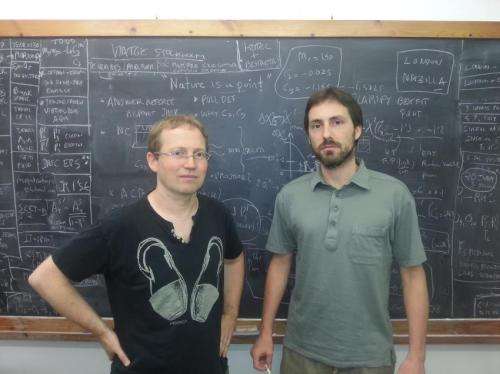First experimental signs of a New Physics beyond the Standard Model

The Standard Model, which has given the most complete explanation up to now of the universe, has gaps, and is unable to explain phenomena like dark matter or gravitational interaction between particles. Physicists are therefore seeking a more fundamental theory that they call "New Physics", but up to now there has been no direct proof of its existence, only indirect observation of dark matter, as deduced, among other things, from the movement of the galaxies.
A team of physicists formed by the professor of Physics at Universitat Autònoma de Barcelona (UAB) Joaquim Matias, Javier Virto, postdoctoral researcher at the same university, and Sebastien Descotes Genon, from the Centre National de la Recherche Scientifique (CNRS) / Université Paris-Sud, has predicted that New Physics would implie the existence of deviations in the probability of a very specific decay of a particle, the B meson. Detecting these small deviations through an experiment would be the first direct proof of the existence of this fundamental theory.
On 19 July of this year, at the EPS 2013 international conference on particle physics in Stockholm, scientists at the LHCb detector, one of the large experiments being conducted by the CERN's LHC accelerator, presented the results of the experimental measurements of the B meson decay. The measurements showed deviations with respect to the predictions of the Standard Model that were previously calculated by UAB and CNRS researchers. The team of scientists have proved that all these deviations show a coherent pattern and that has allowed them to identify their origin from a unique source.
The results of their analysis point to a deviation from the Standard Model prediction of 4.5 sigmas. If confirmed, this is a major event, since scientists regard 3 sigmas as "scientific proof" of New Physics and 5 sigmas as a "discovery".
"We must be prudent, because more studies and more experimental measurements will be needed for confirmation", explains Joaquim Matias, "but if they are confirmed this is the first direct proof of New Physics, a more general theory than the current Standard Model". "If the Higgs completed the Standard Model puzzle, these findings could be the first piece in an even bigger puzzle, adds Dr Matias.
The researchers claim that one of the New Physics models that could explain these results would be the one that postulates the existence of a new particle named Zprima, "but there could be lots of compatible models", points out Dr Matias.
The findings are so interesting that scientists at the other main LHC experiment, the CMS detector, want to take these measurements. The CMS has invited Dr. Matias to explain the theoretical details in a seminar to see it the results can be corroborated. At the same time, LHCb is also adding new data to improve the statistics and confirm the measurements next March.
Also participating in the study were Javier Virto, from the UAB's Department of Physics, and Sebastien Descotes-Genon from the University of Paris-Sud 11.
Beyond the Standard Model
For years, particle physicists have known that the theory they use, the Standard Model, despite being a very successful model in all tests carried out so far, has significant deficiencies such as lack of a candidate for dark matter. In addition, it has other problems such as the so-called fundamental problem of hierarchies or the matter-antimatter asymmetry of the universe.
Two of the central goals of the Large Hadron Collider (LHC) at CERN (Geneva) are finding the Higgs boson and finding what is called New Physics, a more fundamental and general theory than that of the Standard Model in which the latter would be just one particular case. Just a year ago, the Higgs boson was discovered, but the particle seems to fit perfectly into the Standard Model and currently gives us no clues regarding New Physics.
Results presented in the EPS 2013 conference
At CERN there are four experiments, four large detectors (ATLAS, CMS, LHCb, and Alice) that record collisions between particles so that scientists can study their behaviour. The LHCb detector is designed to study the behaviour of quarks and what are known as rare decays, which are very infrequent.
On 19 July of this year, at EPS 2013, the European Physics Society's International Conference on Particle Physics, in Stockholm, Dr. Matias presented the theoretical predictions of his research team on one of these decays: that of a B meson, formed by a b quark and a d antiquark, into a pair of muons and a particle called K*. The UAB and CNRS researchers calculated and predicted how this decay should work and how it should change in different New Physics scenarios.
Shortly afterwards, an experimental physicist from the LHCb detector, Nicola Serra, presented at the same conference the first completed experimental results of that decay. Surprisingly, the experimental measurements were consistent with the deviations predicted by Joaquim Matias and his collaborators. For the first time, deviations of this type were consistent with theoretical predictions based on the presence of contributions that transcends the Standard Model.
More information: — N. Serra, Studies of electroweak penguin transitions of b->smumu, talk given at EPS-HEP Conference, Stockholm, July 2013.
— J. Matias, Optimizing the basis of B->K* l+l- observables and understanding its tensions, talk given at EPS-HEP Conference, Stockholm, July 2013.
— Sebastien Descotes-Genon (Orsay), Joaquim Matias and Javier Virto (Barcelona UAB), Understanding the B->K*mu+mu- anomaly, e-Print: arXiv:1307.5683 [hep-ph] arxiv.org/abs/1307.5683
Provided by Universitat Autonoma de Barcelona

















